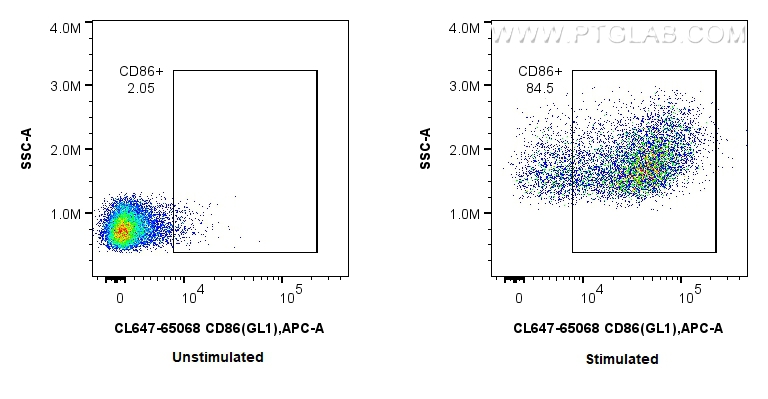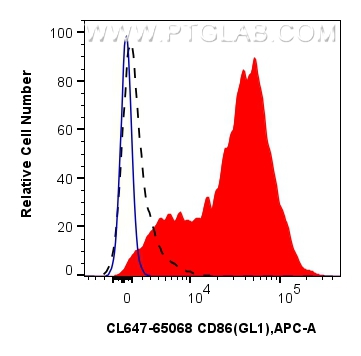验证数据展示
经过测试的应用
| Positive FC detected in | LPS treated mouse splenocytes |
推荐稀释比
| 应用 | 推荐稀释比 |
|---|---|
| Flow Cytometry (FC) | FC : 0.25 ug per 10^6 cells in a 100 µl suspension |
| This reagent has been tested for flow cytometric analysis. It is recommended that this reagent should be titrated in each testing system to obtain optimal results. | |
| Sample-dependent, Check data in validation data gallery. | |
产品信息
CL647-65068 targets CD86 in FC applications and shows reactivity with mouse samples.
| 经测试应用 | FC Application Description |
| 经测试反应性 | mouse |
| 免疫原 |
LPS-activated CBA/Ca mouse spleen B cells 种属同源性预测 |
| 宿主/亚型 | Rat / IgG2a, kappa |
| 抗体类别 | Monoclonal |
| 产品类型 | Antibody |
| 全称 | CD86 antigen |
| 别名 | B7, B7 2, B7.2, B70, B7-2 |
| GenBank蛋白编号 | BC013807 |
| 基因名称 | Cd86 |
| Gene ID (NCBI) | 12524 |
| RRID | AB_2883663 |
| 偶联类型 | CoraLite® Plus 647 Fluorescent Dye |
| 最大激发/发射波长 | 654 nm / 674 nm |
| 形式 | Liquid |
| 纯化方式 | Affinity purification |
| UNIPROT ID | P42082 |
| 储存缓冲液 | PBS with 0.09% sodium azide and 0.5% BSA, pH 7.3. |
| 储存条件 | Store at 2-8°C. Avoid exposure to light. Stable for one year after shipment. |
背景介绍
CD86 (also known as B7-2) is a costimulatory molecule belonging to the immunoglobulin superfamily. Primarily expressed on antigen-presenting cells (APCs), including B cells, dendritic cells, and macrophages, CD86 is the ligand for two proteins at the cell surface of T cells, CD28 antigen and CTLA-4. Binding of CD86 with CD28 antigen is a costimulatory signal for activation of the T-cell. Binding of CD86 with CTLA-4 negatively regulates T-cell activation and diminishes the immune response. (PMID: 7513726; 1847722; 11029388; 27591335)
实验方案
| Product Specific Protocols | |
|---|---|
| FC protocol for CL Plus 647 CD86 antibody CL647-65068 | Download protocol |
| Standard Protocols | |
|---|---|
| Click here to view our Standard Protocols |



